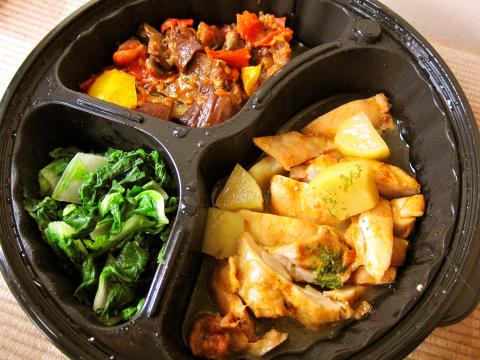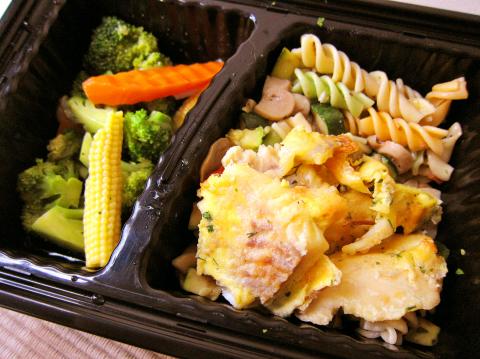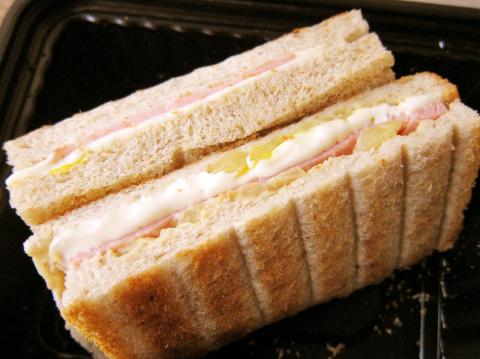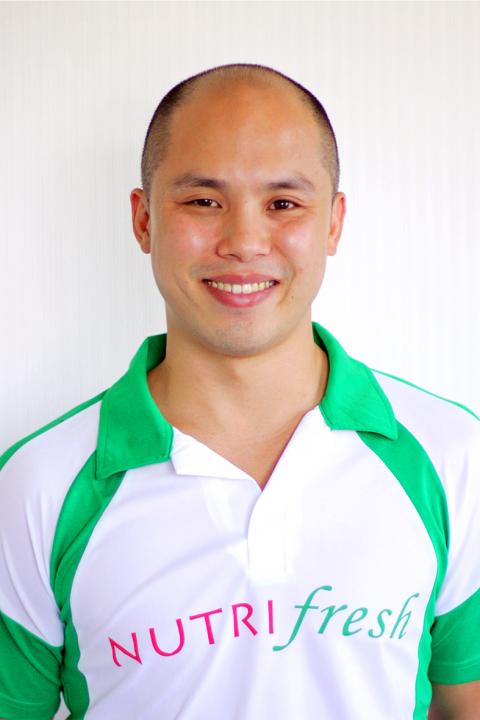During six years on Wall Street, Steve Ho’s (何思漳) career in finance flourished — and so did his waistline. Working long hours at a hedge fund, Ho’s lunch breaks consisted of eating Indian or Chinese takeout at his desk, and he often spent evenings grabbing drinks with potential clients.
After losing his job during 2008’s financial crisis, Ho, who was born in Taiwan but grew up in Texas, returned to his home country. He intended to take a break and get healthy before moving on to another financial job in Shanghai, Hong Kong or Singapore, but while hitting the gym and carefully planning meals as part of his new fitness regime, Ho saw a business opportunity. His company Nutrifresh (新鮮營養), which delivers freshly prepared meals in Taipei City and parts of New Taipei City on weekday mornings, was launched a year ago and is targeted at people who are too busy to cook for themselves but want an alternative to fast food.
“You commit all this time to your career, but suddenly you can’t eat healthy,” Ho says. “You look in the mirror every day, you put on your clothes and feel them pinch. You feel like you are stuck in a rut.”

Photo: Catherine Shu, Taipei Times
Nutrifresh’s goal is to get customers out of that rut and help them develop better eating habits. Ho says the company, which offers several pricing plans and delivers in the morning, currently has about 160 to 170 subscribers. Nutrifresh describes its cuisine as international and meals include fresh salads, homemade granola, low-fat curries, wraps and grilled lean meats flavored with a wide variety of sauces. Nutritional information is provided for each day’s menu on the company’s Web site (www.nutrifresh.com.tw).
Eunice Chu (褚懿涵), a 28-year-old online English tutor, started subscribing to Nutrifresh in June after she got tired of cooking for herself. Chu says the company’s full meal plan (which consists of lunch, dinner and two snacks and provides 1,200 to 1,600 calories per day) is enough to keep her feeling full even after her regular half-hour jogs or yoga sessions.
“[Nutrifresh] surprises me very often with the taste of their food, because usually when you think of healthy food, you think of something that’s not exciting, but they actually taste very good,” says Chu, who plans to stay on the program indefinitely.

Photo: Catherine Shu, Taipei Times
She says the program has helped change her eating habits.
“Now I try to stay away from anything greasy, oily or deep-fried. I’ve lost my appetite for those things,” Chu says.
Ho says Nutrifresh’s customers are split evenly between men and women; many work in middle-management positions at large, multinational firms. They are usually in their mid-30s to mid-40s and order Nutrifresh for the convenience.

Photo: Catherine Shu, Taipei Times
“Most of our clients are just too busy to prepare healthy meals,” Ho explains.
He says that Nutrifresh’s focus is on healthy eating, not dieting, but that clients have reported weight loss when they combine their meal plan with regular exercise and watch what they eat on weekends. While some of Nutrifresh’s clients have stayed with the program since it launched last summer, Ho originally anticipated that customers would subscribe for three or four months as a launching pad toward better lifestyle habits. Subscriptions jumped right after the Lunar New Year, he says.
“Everyone is trying to repair themselves after having been gluttonous,” he says.

Photo: Catherine Shu, Taipei Times
Nutrifresh’s menus are designed by Ho and chef Shih Hung-jen (施弘任) using recipes adapted from cookbooks and the Internet, or developed by Nutrifresh’s cooks. In order to keep track of each item’s calorie count, fat grams and nutrients, Ho measures all ingredients and enters them into recipe management software purchased from a consultancy vendor that uses nutritional data from the United States Department of Agriculture (USDA).
Ho sticks to a plan based on a modified version of the Zone diet, which focuses on a balanced ratio of lean protein, carbohydrates and fats. He says his meal plans usually consist of 40 percent protein, 40 percent carbohydrates (most of which comes from complex carbs like fresh fruit, vegetables or whole grains) and 20 percent fat from olive oil, nuts and dairy products like yogurt or cheese. To keep flavors appealing, Shih uses low-calorie spices, seasonings and sauces.
During the summer, Nutrifresh’s offerings include chilled soups and cold dinners like tilapia with cucumber salad. When winter arrives, Shih says the company will serve hot meals that are comforting but still healthy.
“Every week, Steve and I figure out how to create a balanced menu. We consider how it works with the weather. For example, in the summer, people get tired and worn out from the heat, so we include things that can be served cool and will boost their energy,” says Shih, who has 12 years of cooking experience, including a position creating meals for patients at Taipei Medical University Hospital (台北醫學大學附設醫院).
Though Nutrifresh does not design individualized meal plans, it accommodates dietary needs, food allergies and flavor preferences (for example, a quarter of Nutrifresh’s customers do not eat beef and about half ask for non-spicy dishes). Vegetarian and vegan meal plans are available, with most protein coming from tofu and other soy derivatives.
While Nutrifresh’s pricing (a 20-day batch of full meal plan deliveries costs NT$9,500 for a single order or NT$9,000 for plans automatically renewed with a credit card) might seem steep to customers who are used to paying NT$60 for a lunchbox, Ho argues that his company’s pricing is reasonable considering the amount of time spent preparing meals, the use of pricier ingredients like nuts and door-to-door delivery.
“It’s more than what people spend on biandang (便當, or lunchbox), but that’s because we aren’t selling biandang,” Ho says.
Ho hopes to eventually offer breakfast options, weekend deliveries and service to Taoyuan County. In the next few months, the Nutrifresh brand will expand with Nutrifit, which will offer one-on-one fitness sessions (a Nutrifresh staffer is currently working toward certification as a personal trainer), and Fresh, a cafe near the corner of Dunhua North Road and Minsheng East Road that will open in October and feature a salad bar along with other quick, low-fat meals.
“Most of our customers are not trend dieters,” Ho says. “[Nutrifresh] is about being healthy.”
On the plan
I decided to try the Nutrifresh system because I had been making an effort to eat healthier, but was bored with my homemade regime of low-fat tuna salads, steamed vegetables, brown rice, fruit smoothies and pureed soups. To get the full Nutrifresh experience, I started with a 20-day order of the full meal plan for NT$9,500. (10 partial packages are also available, starting from one that includes a light meal and snack. It is priced at NT$1,425 for five days and NT$5,500 for 20 days.) There is a three day per week minimum order; I opted to receive my meals from Monday to Friday.
My food is delivered to my apartment door in the morning between 9am and 11am (earlier deliveries are available in some areas). Following Nutrifresh’s suggestions, I eat the largest meal (called the dinner meal in Nutrifresh’s brochures) first around 11am, followed by the two snacks at three-hour intervals, and the light meal (referred to as the lunch meal) at 8pm. That schedule succeeds in keeping most hunger pangs and food cravings at bay (unless one of the day’s snacks is sliced fruit, in which case I supplement it with a Soyjoy bar or slice of whole wheat bread).
Nutrifresh’s dinner meal usually consists of a lean meat like skinless chicken breast, pork or steamed fish with two vegetable sides, while the lunch meals often feature a wrap or salad tossed with a protein (such as chicken or shrimp) and served with a light dressing. While I enjoyed most of the meals, a few — like a dry tomato and tuna salad with bland lemon and orange chicken and string beans — tasted too much like “diet food.” I also found several cold salads made with couscous to be too sweet.
On the other hand, I liked all of the steamed fish entrees, chicken dishes flavored with yogurt-based sauces and most snacks, which range from chicken or beef kebabs to delicious granola freshly made with whole oats and sweetened with honey.
Ho says Nutrifresh currently has an eight-week repertoire of snacks and 12 weeks of meal recipes. Over my six weeks on the program so far, only a couple of meals have been repeated, while some snacks, like fruit salads and granola, show up more frequently than others. (I am always glad to see the granola, especially when it is flavored with peanut butter or chocolate.)
Though the cost of my Nutrifresh plan is more than what I usually pay per month for food, I found that investing the money keeps me motivated to stay on track with healthy eating, even on weekends. I avoid meals at fast food restaurants, impulse snacking and indulging in desserts too often because I do not want to undo the Nutrifresh program’s benefits.
Though I have lost about 1.5kg over the past six weeks, I feel like the biggest difference is in my energy levels, which increased significantly by the second week I was on the program. (I would probably lose more weight if I used my newly gained energy to ramp up my exercise regime, which currently consists of long but leisurely walks a few times per week). After a couple weeks on the program, I also began to get a better sense of what healthy portion sizes for different foods look like (I measured a few dishes with a food scale to double-check my estimates) and some ideas for meals to cook myself after I stop subscribing.
If I continue with the program, I may switch to one of the less expensive partial meal plans and prepare more economical, portable snacks at home. (Some of Nutrifresh’s offerings, like cheese beef meatballs with tomatoes, are tasty but hard to toss into your purse.)
As with any nutritional or diet program, check with your doctor first, especially if you have a health condition like high blood pressure, high cholesterol or diabetes.
For more information about Nutrifresh and a list of pricing plans (including a five-day NT$1,500 trial), visit the company’s Web site at www.nutrifresh.com.tw, which is in Chinese and English, or call (02) 8773-6002)

In the March 9 edition of the Taipei Times a piece by Ninon Godefroy ran with the headine “The quiet, gentle rhythm of Taiwan.” It started with the line “Taiwan is a small, humble place. There is no Eiffel Tower, no pyramids — no singular attraction that draws the world’s attention.” I laughed out loud at that. This was out of no disrespect for the author or the piece, which made some interesting analogies and good points about how both Din Tai Fung’s and Taiwan Semiconductor Manufacturing Co’s (TSMC, 台積電) meticulous attention to detail and quality are not quite up to

April 21 to April 27 Hsieh Er’s (謝娥) political fortunes were rising fast after she got out of jail and joined the Chinese Nationalist Party (KMT) in December 1945. Not only did she hold key positions in various committees, she was elected the only woman on the Taipei City Council and headed to Nanjing in 1946 as the sole Taiwanese female representative to the National Constituent Assembly. With the support of first lady Soong May-ling (宋美齡), she started the Taipei Women’s Association and Taiwan Provincial Women’s Association, where she

It is one of the more remarkable facts of Taiwan history that it was never occupied or claimed by any of the numerous kingdoms of southern China — Han or otherwise — that lay just across the water from it. None of their brilliant ministers ever discovered that Taiwan was a “core interest” of the state whose annexation was “inevitable.” As Paul Kua notes in an excellent monograph laying out how the Portuguese gave Taiwan the name “Formosa,” the first Europeans to express an interest in occupying Taiwan were the Spanish. Tonio Andrade in his seminal work, How Taiwan Became Chinese,

Mongolian influencer Anudari Daarya looks effortlessly glamorous and carefree in her social media posts — but the classically trained pianist’s road to acceptance as a transgender artist has been anything but easy. She is one of a growing number of Mongolian LGBTQ youth challenging stereotypes and fighting for acceptance through media representation in the socially conservative country. LGBTQ Mongolians often hide their identities from their employers and colleagues for fear of discrimination, with a survey by the non-profit LGBT Centre Mongolia showing that only 20 percent of people felt comfortable coming out at work. Daarya, 25, said she has faced discrimination since she